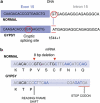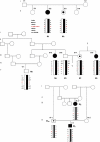Founder effect and estimation of the age of the French Gypsy mutation associated with Glanzmann thrombasthenia in Manouche families
- PMID: 21487445
- PMCID: PMC3179361
- DOI: 10.1038/ejhg.2011.61
Founder effect and estimation of the age of the French Gypsy mutation associated with Glanzmann thrombasthenia in Manouche families
Abstract
The c.1544+1G>A substitution at the 5' splice donor site of intron 15 of the ITGA2B gene, called the French Gypsy mutation, causes Glanzmann thrombasthenia, an inherited hemorrhagic disorder transmitted as an autosomal recessive trait and characterized by an altered synthesis of the platelet αIIbβ3 integrin. So far, this mutation has only been found in affected individuals originating from French Manouche families, strongly suggesting a founder effect. Our goal was to investigate the origin of the French Gypsy mutation. We estimated the age of the mutation by a likelihood-based method that uses the length of the shared haplotypes among a set of patients. For this, we genotyped 23 individuals of Manouche origin; consisting of 9 Glanzmann thrombasthenia patients homozygous for the French Gypsy mutation, 6 heterozygous carriers and 8 homozygous wild-type individuals. They were genotyped for four single-nucleotide polymorphisms using high-resolution melting curve analysis, and for two CA repeats in the BRCA1 and THRA genes at chromosome 17, using fragment analysis gels. We found that a haplotype of five polymorphic loci covering a 4-cM region was strongly associated with the French Gypsy mutation, suggesting a founder effect. The estimated age of this founder mutation was 300-400 years (range 255-552 years). Thus, all carriers of the French Gypsy mutation c.1544+1G>A at intron 15 descended from a common ancestor 300-400 years ago.
Figures



 , European migration in Balkans
, European migration in Balkans  , migration in Germany
, migration in Germany  , introduction of the French Gypsy mutation in France and founder effect
, introduction of the French Gypsy mutation in France and founder effect  .
.Similar articles
-
Immunization against αIIb β3 and αv β3 in Glanzmann thrombasthenia patients carrying the French Gypsy mutation.J Thromb Haemost. 2021 Jan;19(1):255-261. doi: 10.1111/jth.15117. Epub 2020 Nov 18. J Thromb Haemost. 2021. PMID: 33090654
-
Expanding the Mutation Spectrum Affecting αIIbβ3 Integrin in Glanzmann Thrombasthenia: Screening of the ITGA2B and ITGB3 Genes in a Large International Cohort.Hum Mutat. 2015 May;36(5):548-61. doi: 10.1002/humu.22776. Hum Mutat. 2015. PMID: 25728920
-
Natural history of platelet antibody formation against αIIbβ3 in a French cohort of Glanzmann thrombasthenia patients.Haemophilia. 2012 May;18(3):e201-9. doi: 10.1111/j.1365-2516.2011.02744.x. Epub 2012 Jan 18. Haemophilia. 2012. PMID: 22250950
-
Glanzmann thrombasthenia-like syndromes associated with Macrothrombocytopenias and mutations in the genes encoding the αIIbβ3 integrin.Semin Thromb Hemost. 2011 Sep;37(6):698-706. doi: 10.1055/s-0031-1291380. Epub 2011 Nov 18. Semin Thromb Hemost. 2011. PMID: 22102273 Review.
-
Should studies on Glanzmann thrombasthenia not be telling us more about cardiovascular disease and other major illnesses?Blood Rev. 2017 Sep;31(5):287-299. doi: 10.1016/j.blre.2017.03.005. Epub 2017 Apr 4. Blood Rev. 2017. PMID: 28395882 Review.
Cited by
-
Glanzmann thrombasthenia: state of the art and future directions.Semin Thromb Hemost. 2013 Sep;39(6):642-55. doi: 10.1055/s-0033-1353393. Epub 2013 Aug 8. Semin Thromb Hemost. 2013. PMID: 23929305 Free PMC article. Review.
-
Specifications of the variant curation guidelines for ITGA2B/ITGB3: ClinGen Platelet Disorder Variant Curation Panel.Blood Adv. 2021 Jan 26;5(2):414-431. doi: 10.1182/bloodadvances.2020003712. Blood Adv. 2021. PMID: 33496739 Free PMC article.
-
Glanzmann thrombasthenia in Pakistan: molecular analysis and identification of novel mutations.Clin Genet. 2016 Feb;89(2):187-92. doi: 10.1111/cge.12622. Epub 2015 Jul 15. Clin Genet. 2016. PMID: 26096001 Free PMC article.
-
Profiling the Genetic and Molecular Characteristics of Glanzmann Thrombasthenia: Can It Guide Current and Future Therapies?J Blood Med. 2021 Jul 8;12:581-599. doi: 10.2147/JBM.S273053. eCollection 2021. J Blood Med. 2021. PMID: 34267570 Free PMC article. Review.
-
In vitro characterization of rare anti-αIIbβ3 isoantibodies produced by patients with Glanzmann thrombasthenia that severely block fibrinogen binding and generate procoagulant platelets via complement activation.Res Pract Thromb Haemost. 2023 Nov 4;8(1):102253. doi: 10.1016/j.rpth.2023.102253. eCollection 2024 Jan. Res Pract Thromb Haemost. 2023. PMID: 38268518 Free PMC article.
References
-
- Seligsohn U, Rososhansky S. A Glanzmann's thrombasthenia cluster among Iraqi Jews in Israel. Thromb Haemost. 1984;52:230–231. - PubMed
-
- Awidi AS. Increased incidence of Glanzmann's thrombasthenia in Jordan as compared with Scandinavia. Scand J Haematol. 1983;30:218–222. - PubMed
-
- Piippo K, Laitinen P, Swan H, et al. Homozygosity for a HERG potassium channel mutation causes a severe form of long QT syndrome: identification of an apparent founder mutation in the Finns. J Am Coll Cardiol. 2000;35:1919–1925. - PubMed
-
- Heyer E. One founder/one gene hypothesis in a new expanding population: saguenay (Quebec, Canada) Hum Biol. 1999;71:99–109. - PubMed
Publication types
MeSH terms
Substances
LinkOut - more resources
Full Text Sources
Miscellaneous

